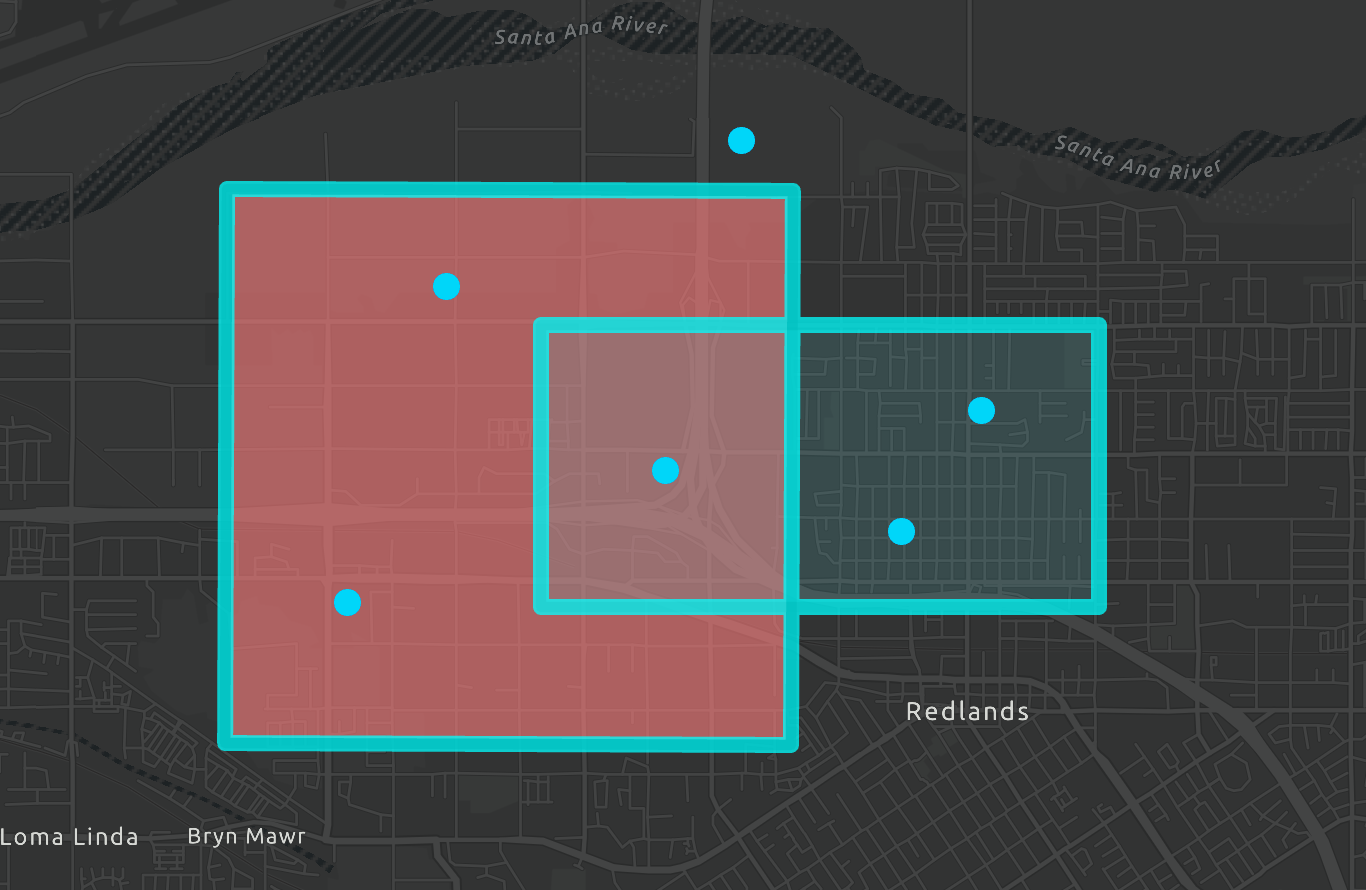Point In Polygon: Processor#
Table of Contents#
[ ]:
import bdt
bdt.auth("bdt.lic")
from bdt import functions as F
from bdt import processors as P
from pyspark.sql.types import StructType, StructField, StringType, IntegerType
BDT has been successfully authorized!
Welcome to
___ _ ___ __ ______ __ __ _ __
/ _ ) (_) ___ _ / _ \ ___ _ / /_ ___ _ /_ __/ ___ ___ / / / /__ (_) / /_
/ _ | / / / _ `/ / // // _ `// __// _ `/ / / / _ \/ _ \ / / / '_/ / / / __/
/____/ /_/ \_, / /____/ \_,_/ \__/ \_,_/ /_/ \___/\___//_/ /_/\_\ /_/ \__/
/___/
BDT python version: v3.4.0-v3.4.0
BDT jar version: v3.4.0-v3.4.0
Part 1: Generate Sample Data#

Both the Polygon and Point Dataframes are created from scratch by specifying the data and schema
A unique identifier and the associated WKT value are added to each row
Create the Polygon Data#
[ ]:
polygon1 = """POLYGON ((-117.17 34.08,
-117.17 34.06,
-117.21 34.06,
-117.21 34.08))"""
polygon2 = """POLYGON ((-117.23 34.09,
-117.19 34.08,
-117.19 34.05,
-117.23 34.05))"""
polySchema = StructType([StructField("POLY_ID", IntegerType()),
StructField("POLY_WKT",StringType())])
polyData = [(1, polygon1),
(2, polygon2)]
polyDF = spark.createDataFrame(data = polyData, schema = polySchema)
polyDF.show(truncate = True)
+-------+--------------------+
|POLY_ID| POLY_WKT|
+-------+--------------------+
| 1|POLYGON ((-117.17...|
| 2|POLYGON ((-117.23...|
+-------+--------------------+
Create the Point Data#
[ ]:
point1 = "POINT (-117.21 34.08)"
point2 = "POINT (-117.22 34.06)"
point3 = "POINT (-117.20 34.07)"
point4 = "POINT (-117.18 34.07)"
point5 = "POINT (-117.18 34.07)"
point6 = "POINT (-117.20 34.09)"
pointSchema = StructType([StructField("POINT_ID", IntegerType()),
StructField("POINT_WKT",StringType())])
pointData = [(1, point1),
(2, point2),
(3, point3),
(4, point4),
(5, point5),
(6, point6)]
pointDF = spark.createDataFrame(data = pointData, schema = pointSchema)
pointDF.show(truncate = True)
+--------+--------------------+
|POINT_ID| POINT_WKT|
+--------+--------------------+
| 1|POINT (-117.21 34...|
| 2|POINT (-117.22 34...|
| 3|POINT (-117.20 34...|
| 4|POINT (-117.18 34...|
| 5|POINT (-117.18 34...|
| 6|POINT (-117.20 34...|
+--------+--------------------+
Part 2: Point in Polygon#
Create SHAPE structs in each DataFrame#
st_FromText converts a WKT representation of a geometry to BDT’s internal Shape Struct object. The default convention is to label this Shape Struct as ‘SHAPE’.
[ ]:
polyDF_S = polyDF\
.select("*", F.st_fromText("POLY_WKT").alias("SHAPE"))\
.withMeta("POLYGON", 4326)
polyDF_S.show()
+-------+--------------------+--------------------+
|POLY_ID| POLY_WKT| SHAPE|
+-------+--------------------+--------------------+
| 1|POLYGON ((-117.17...|{[01 06 00 00 00 ...|
| 2|POLYGON ((-117.23...|{[01 06 00 00 00 ...|
+-------+--------------------+--------------------+
[ ]:
pointDF_S = pointDF\
.select("*", F.st_fromText("POINT_WKT").alias("SHAPE"))\
.withMeta("POINT", 4326)
pointDF_S.show(3)
+--------+--------------------+--------------------+
|POINT_ID| POINT_WKT| SHAPE|
+--------+--------------------+--------------------+
| 1|POINT (-117.21 34...|{[01 01 00 00 00 ...|
| 2|POINT (-117.22 34...|{[01 01 00 00 00 ...|
| 3|POINT (-117.20 34...|{[01 01 00 00 00 ...|
+--------+--------------------+--------------------+
only showing top 3 rows
Processor PointInPolygon (PIP)#
Processor PIP is a highly optimized and easy to use method for running point in polygon jobs.
Set the cell size to 5 degrees
cellSize determines the QR value(s) assigned to a given geometry
[ ]:
cellSize = 5.0
Call the processor, passing in the two DataFrames as the first arguments (point DataFrame then polygon DataFrame) and then the other required and optional parameters. * setting take = 2 means up to 2 overlapping polygons will be returned for a given point * setting emitPippedOnly = true means only points that are contained within a polygon will be returned in the output
[ ]:
pipped = P.pip(pointDF_S,
polyDF_S,
cellSize=cellSize,
take = 2,
emitPippedOnly = True)
print(pipped.count())
pipped.show(3)
6
+--------+--------------------+--------------------+-------+--------------------+
|POINT_ID| POINT_WKT| SHAPE|POLY_ID| POLY_WKT|
+--------+--------------------+--------------------+-------+--------------------+
| 1|POINT (-117.21 34...|{[01 01 00 00 00 ...| 2|POLYGON ((-117.23...|
| 3|POINT (-117.20 34...|{[01 01 00 00 00 ...| 2|POLYGON ((-117.23...|
| 3|POINT (-117.20 34...|{[01 01 00 00 00 ...| 1|POLYGON ((-117.17...|
+--------+--------------------+--------------------+-------+--------------------+
only showing top 3 rows